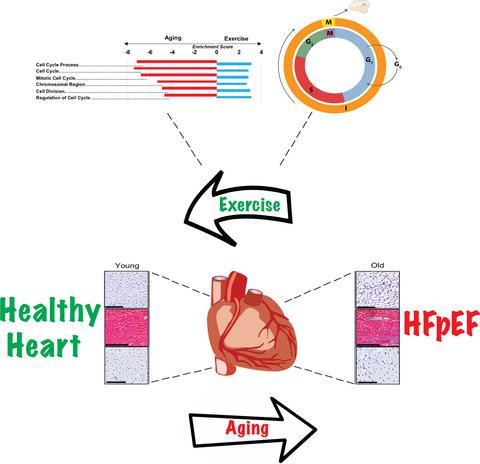当前位置:
X-MOL 学术
›
Aging Cell
›
论文详情
Our official English website, www.x-mol.net, welcomes your feedback! (Note: you will need to create a separate account there.)
Exercise training reverses cardiac aging phenotypes associated with heart failure with preserved ejection fraction in male mice.
Aging Cell ( IF 7.8 ) Pub Date : 2020-05-22 , DOI: 10.1111/acel.13159 Jason D Roh 1 , Nicholas Houstis 1 , Andy Yu 1 , Bliss Chang 1 , Ashish Yeri 1 , Haobo Li 1 , Ryan Hobson 1 , Carolin Lerchenmüller 2 , Ana Vujic 3 , Vinita Chaudhari 1 , Federico Damilano 1 , Colin Platt 1 , Daniel Zlotoff 1 , Richard T Lee 3 , Ravi Shah 1 , Michael Jerosch-Herold 4 , Anthony Rosenzweig 1
Aging Cell ( IF 7.8 ) Pub Date : 2020-05-22 , DOI: 10.1111/acel.13159 Jason D Roh 1 , Nicholas Houstis 1 , Andy Yu 1 , Bliss Chang 1 , Ashish Yeri 1 , Haobo Li 1 , Ryan Hobson 1 , Carolin Lerchenmüller 2 , Ana Vujic 3 , Vinita Chaudhari 1 , Federico Damilano 1 , Colin Platt 1 , Daniel Zlotoff 1 , Richard T Lee 3 , Ravi Shah 1 , Michael Jerosch-Herold 4 , Anthony Rosenzweig 1
Affiliation

|
Heart failure with preserved ejection fraction (HFpEF) is the most common type of HF in older adults. Although no pharmacological therapy has yet improved survival in HFpEF, exercise training (ExT) has emerged as the most effective intervention to improving functional outcomes in this age‐related disease. The molecular mechanisms by which ExT induces its beneficial effects in HFpEF, however, remain largely unknown. Given the strong association between aging and HFpEF, we hypothesized that ExT might reverse cardiac aging phenotypes that contribute to HFpEF pathophysiology and additionally provide a platform for novel mechanistic and therapeutic discovery. Here, we show that aged (24–30 months) C57BL/6 male mice recapitulate many of the hallmark features of HFpEF, including preserved left ventricular ejection fraction, subclinical systolic dysfunction, diastolic dysfunction, impaired cardiac reserves, exercise intolerance, and pathologic cardiac hypertrophy. Similar to older humans, ExT in old mice improved exercise capacity, diastolic function, and contractile reserves, while reducing pulmonary congestion. Interestingly, RNAseq of explanted hearts showed that ExT did not significantly modulate biological pathways targeted by conventional HF medications. However, it reversed multiple age‐related pathways, including the global downregulation of cell cycle pathways seen in aged hearts, which was associated with increased capillary density, but no effects on cardiac mass or fibrosis. Taken together, these data demonstrate that the aged C57BL/6 male mouse is a valuable model for studying the role of aging biology in HFpEF pathophysiology, and provide a molecular framework for how ExT potentially reverses cardiac aging phenotypes in HFpEF.
中文翻译:

运动训练可逆转与心力衰竭相关的心脏衰老表型,并在雄性小鼠中保留射血分数。
射血分数保留的心力衰竭 (HFpEF) 是老年人中最常见的 HF 类型。尽管尚无药物疗法改善 HFpEF 的生存率,但运动训练 (ExT) 已成为改善这种与年龄相关疾病的功能结果的最有效干预措施。然而,ExT 在 HFpEF 中诱导其有益作用的分子机制在很大程度上仍然未知。鉴于衰老与 HFpEF 之间的强关联,我们假设 ExT 可能会逆转导致 HFpEF 病理生理学的心脏衰老表型,并另外为新的机制和治疗发现提供平台。在这里,我们展示了老年(24-30 个月)C57BL/6 雄性小鼠概括了 HFpEF 的许多标志性特征,包括保留的左心室射血分数,亚临床收缩功能障碍、舒张功能障碍、心脏储备受损、运动不耐受和病理性心脏肥大。与老年人相似,老年小鼠的 ExT 提高了运动能力、舒张功能和收缩储备,同时减少了肺充血。有趣的是,移植心脏的 RNAseq 显示 ExT 没有显着调节常规 HF 药物靶向的生物途径。然而,它逆转了多种与年龄相关的通路,包括老年心脏中细胞周期通路的整体下调,这与毛细血管密度增加有关,但对心脏质量或纤维化没有影响。综上所述,这些数据表明,老年 C57BL/6 雄性小鼠是研究衰老生物学在 HFpEF 病理生理学中的作用的宝贵模型,
更新日期:2020-05-22
中文翻译:

运动训练可逆转与心力衰竭相关的心脏衰老表型,并在雄性小鼠中保留射血分数。
射血分数保留的心力衰竭 (HFpEF) 是老年人中最常见的 HF 类型。尽管尚无药物疗法改善 HFpEF 的生存率,但运动训练 (ExT) 已成为改善这种与年龄相关疾病的功能结果的最有效干预措施。然而,ExT 在 HFpEF 中诱导其有益作用的分子机制在很大程度上仍然未知。鉴于衰老与 HFpEF 之间的强关联,我们假设 ExT 可能会逆转导致 HFpEF 病理生理学的心脏衰老表型,并另外为新的机制和治疗发现提供平台。在这里,我们展示了老年(24-30 个月)C57BL/6 雄性小鼠概括了 HFpEF 的许多标志性特征,包括保留的左心室射血分数,亚临床收缩功能障碍、舒张功能障碍、心脏储备受损、运动不耐受和病理性心脏肥大。与老年人相似,老年小鼠的 ExT 提高了运动能力、舒张功能和收缩储备,同时减少了肺充血。有趣的是,移植心脏的 RNAseq 显示 ExT 没有显着调节常规 HF 药物靶向的生物途径。然而,它逆转了多种与年龄相关的通路,包括老年心脏中细胞周期通路的整体下调,这与毛细血管密度增加有关,但对心脏质量或纤维化没有影响。综上所述,这些数据表明,老年 C57BL/6 雄性小鼠是研究衰老生物学在 HFpEF 病理生理学中的作用的宝贵模型,


























 京公网安备 11010802027423号
京公网安备 11010802027423号